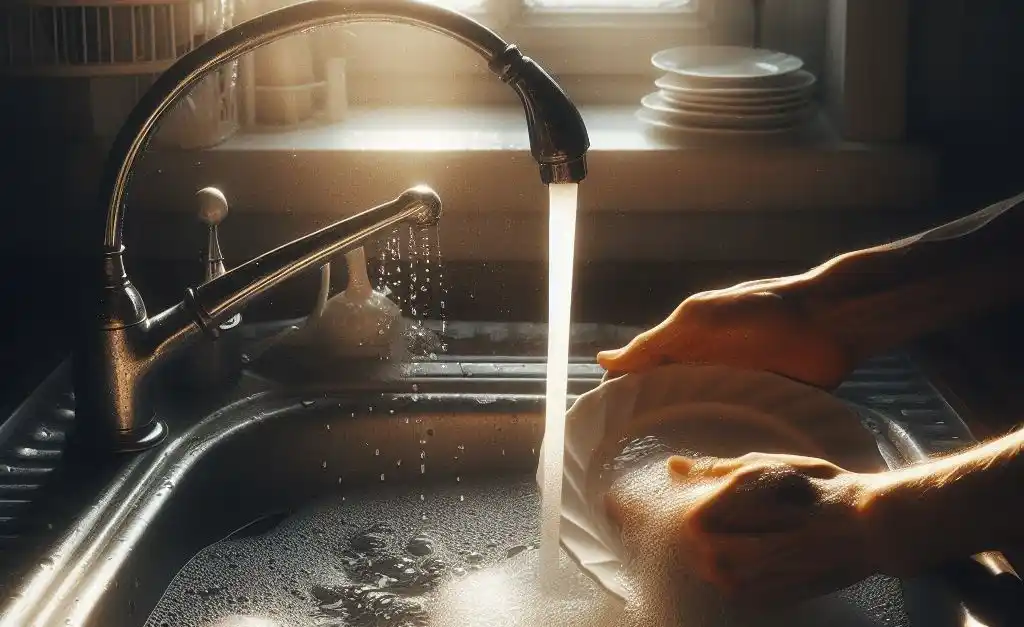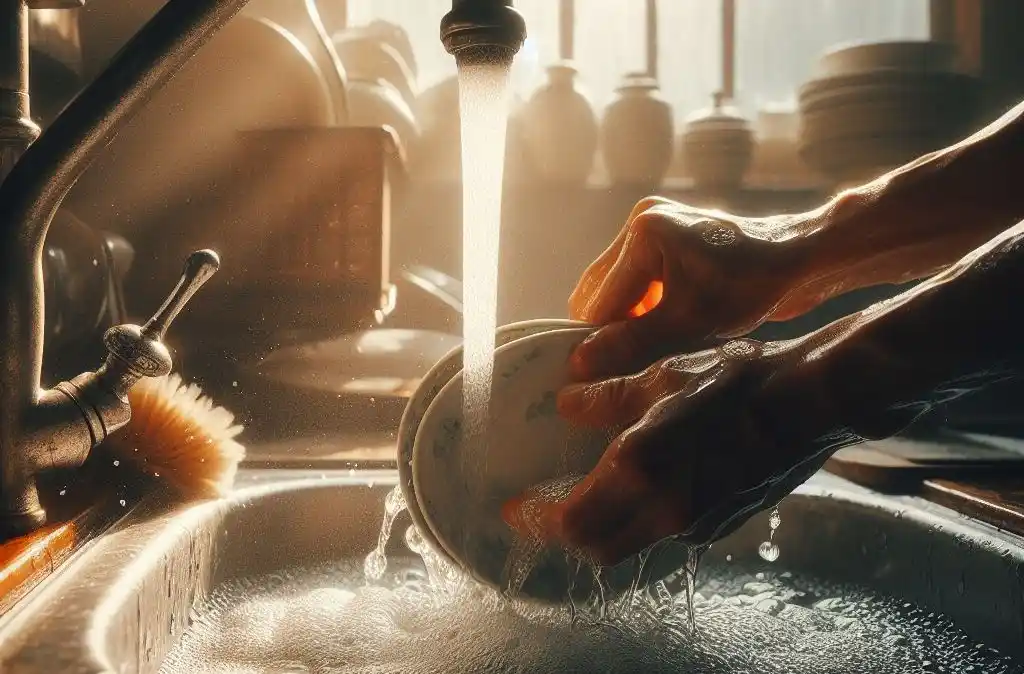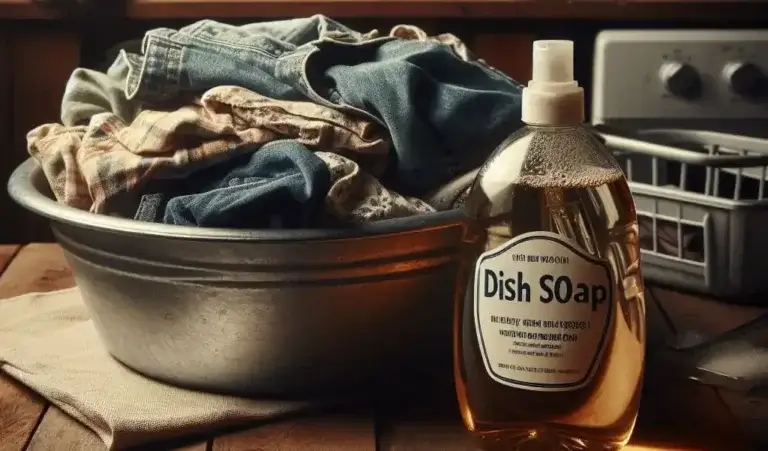How to Wash Dishes at a Restaurant: Commercial Kitchen Dishwashing
Washing dishes in a commercial kitchen requires careful attention to cleanliness, sanitization, and organization. Proper dishwashing is crucial for food safety and efficient restaurant operations. This comprehensive guide covers everything you need to know about how to wash dishes at a restaurant.
Table of Contents
Introduction to Commercial Dishwashing
Washing dishes in a restaurant kitchen is very different than washing dishes at home. Commercial kitchens handle high volumes of dishes and must meet strict health code regulations for sanitization. Additionally, restaurants use industrial-grade dishwashing equipment and chemicals not found in a home kitchen.
There are several reasons proper dishwashing is so important in restaurants:
- Prevent Foodborne Illness – Sanitizing dishes, glassware, and utensils kills dangerous pathogens like E. coli and Salmonella that cause food poisoning.
- Food Safety – Clean dishware prevents cross-contamination from raw to cooked foods.
- Customer Confidence – Visibly dirty plates, cups, and utensils appear unappetizing and turn off customers.
- Efficiency – An organized dishwashing system keeps the kitchen running smoothly to serve more covers. Slow or improper dishwashing creates bottlenecks.
The consequences of inadequate dishwashing include failing health inspections, foodborne illness outbreaks, decreased customer satisfaction, and lower sales. Later sections will cover specific dish sanitization procedures, but first, let’s overview the standard commercial kitchen dishwashing equipment and setup.
Commercial Dishwashing Equipment
Commercial kitchens utilize heavy-duty dishwashing machines and customized sinks to handle high volumes. Here is an overview of common restaurant dishwashing equipment:
Commercial Dishwashers
Commercial dishwashers use high water pressure, steam heat, and industrial detergents to clean. Types include:
- Conveyor – Dishes ride along a conveyor belt through a series of wash zones with rinse and sanitizing sections. Very fast and efficient.
- Door Type – Dishes are loaded into racks that slide into an enclosed washing chamber. Temperature and wash cycles are automated.
- Undercounter – Compact dishwashers built into a kitchen counter space. Useful for smaller operations.
Dishwashers require careful loading for maximum cleaning efficiency. Specific directions are covered later in this article.
Three-Compartment Sinks
Restaurants are required by health code to have a three-compartment sink for manual dishwashing. Each compartment has a purpose:
- Wash – Filled with hot water and detergent to loosen soil from dishware.
- Rinse – Remove all soap suds and particles from the washing step.
- Sanitize – Submerges dishes in a chemical sanitizing solution.
Some establishments still wash all their dishes by hand in three-compartment sinks due to low volumes or traditional processes.
Dish Tables
Stainless steel prep tables located near the dish area provide space for dirty sorting, clean dish storage, and miscellaneous dishwashing tasks. Some special considerations for dish tables include:
- Non-slip, heatproof surface
- Tables on wheels for flexibility
- Drain plug to handle dumping liquids
- Hanging rack underneath for dish racks
With the key dishwashing equipment explained, let’s look at standard restaurant kitchen workflow.
Commercial Kitchen Dishwashing Workflow
An efficient dishwashing workflow is essential for restaurants to run smoothly. Every kitchen will have a slightly different process based on layout and volume, but here is a standard overview:
1. Dirty Dishes Arrive
- Servers, cooks, and bussers bring dirty plates, glasses, and pans from the dining and kitchen areas.
- Leftover food is scraped into garbage bins before entering the dish area.
- Items are sorted by dishwasher operators based on size, delicacy, and how soiled they are. Delicate glassware is kept separate from heavy stock pots for example.
2. Dishes Loaded & Washed
- Dishwashers pre-rinse excess food debris off dishware if needed before loading it into racks or onto conveyors.
- Dish machines or three-compartment sinks wash dishes removing all leftover food and grease using detergents.
- If bubbles appear in the rinse section, detergent levels are too high and should be adjusted.
3. Dishes Unloaded & Inspected
- Dishwashers visually inspect coming out of the machine for any leftover food or grease.
- Spot-clean any dishes by hand that need extra attention.
- Delicate glassware and serveware is polished and handled carefully.
4. Sanitization
- Dishwashers submerge all dishes, utensils, and cookware into a chemical sanitizing bath.
- Contact time of at least 75°F for 30 seconds kills dangerous bacteria.
- Items are allowed to fully air dry before storage – no towels!
5. Dish Storage & Organization
- Dishes are neatly organized on shelving units in the dish area storage.
- Set up dishware and glassware needed for the next shift to improve efficiency.
- Take note of any equipment shortages and relay them to purchasing.
Those are the standard high-level steps for washing dishes in a commercial kitchen. Effective implementation takes training, practice, and attention to safety. Next, we will get into the nitty gritty details of performing each step correctly.
How to Wash Dishes at a Restaurant – Full Guide

Washing dishes in a restaurant isn’t just about getting plates clean; it’s a fast-paced ballet of efficiency and sanitation. So, whether you’re a seasoned veteran or a newbie stepping into the pit for the first time, these tips will help you conquer the sink like a champion.
Gear Up for Washing:
- Apron and gloves: Protect yourself from splashes and grime. Choose waterproof gloves that offer good dexterity.
- Scrub brushes and sponges: Different tools for different jobs. Stiff brushes tackle baked-on bits, while spongey goodness handles delicate glassware.
- Spray bottle: A trusty sidekick for pre-soaking and blasting stubborn stains.
The Three-Sink Symphony:
Most restaurants use a three-compartment sink system for ultimate sanitation. Here’s the breakdown:
1. Scrape Station: Scrape off leftover food before it becomes a baked-on nightmare. Think of it as pre-game for the real washing action.
2. Wash Zone: Fill the first sink with hot, soapy water (around 110°F). Scrub each dish thoroughly, paying attention to corners and crevices. Rinse with clean water to remove suds.
3. Sanitize Serenade: The final soak in the third sink (filled with hot water and sanitizer) eliminates any lingering bacteria. Let the dishes bask in the sanitizing bath for the recommended time.
Mastering the Flow:
- Organize chaos: Sort dishes into different bins or racks for cutlery, plates, and glasses. This keeps things running smoothly and prevents stacking mishaps.
- Load like a pro: Pack the dishwasher efficiently, following the manufacturer’s guidelines. Leaving enough space for water circulation is key to sparkling results.
- Keep it hot, keep it clean: Regularly monitor the water temperature in all three sinks and replace soapy water when it gets too greasy. Clean your tools throughout the shift to prevent cross-contamination.
Beyond the Suds:
- Safety first: Wear non-slip shoes and be mindful of spills and wet floors. Lifting heavy trays? Use proper technique to avoid injury.
- Teamwork makes the dream work: Communicate with servers and cooks. Let them know when the dishwashing queue is getting backed up, and ask for help when needed.
- Embrace the rhythm: Restaurant dishwashing is a fast-paced environment. Find your flow, stay focused, and take satisfaction in conquering the mountain of dirty dishes.
Remember, washing dishes in a restaurant is more than just a chore; it’s a vital role in keeping the dining experience safe and enjoyable. By following these tips and mastering the rhythm of the dishwashing dance, you’ll be a sudsy superhero in no time!
Manual Dishwashing Procedures
While commercial dishwashers do the heavy lifting, staff must properly scrape, rinse, and sort dishes before loading them into the machine. Additionally, some delicate glassware, serveware, and specialty cookware cannot be machine-washed. Here are the best practices for manual dishwashing steps:
Leftover Food Removal
- Scrape excess food from plates, bowls, pans, and other dishware into garbage bins before placing in the dish area.
- Remove crumbs, bones, and other large debris to prevent drain clogs and keep water cleaner.
- Use rubber scrapers or spatulas to remove stuck-on foods. Do not use metal tools that can scratch surfaces.
1st Sink – Washing
Fill the first sink compartment (or dish machine chamber) with hot water around 110-120°F and detergent. When manually washing:
- Completely submerge dishes and cookware allowing detergent solution to penetrate stuck-on foods.
- Use scrub brushes and abrasive dishcloths to remove foods from surfaces.
- Change out wash water frequently when it becomes greasy or soiled.
- Check detergent levels and water temperature to maintain cleaning efficiency.
Take extra care when washing delicate glassware and serve ware in the first sink compartment:
- Lightly scrub with non-abrasive sponges and soft cloths to prevent scratching.
- Rinse immediately after washing to prevent damage from detergents.
- Use low water pressure from spray valves for crystal, stemware, and fragile items.
2nd Sink – Rinsing
The second sink compartment should contain clean hot rinse water around 110-120°F with no detergent. When manually rinsing:
- Thoroughly rinse all soap suds and food particles from dish surfaces and crevices.
- Pay special attention to removing detergent from glasses – suds compromise sanitization.
- Change rinse water frequently when water becomes cloudy.
- Rinse dishes with spray valves or by dipping rather than soaking to use less water.
3rd Sink – Sanitizing
The third sink contains a chemical sanitizing solution strong enough to eliminate pathogens. Options include:
- Chlorine (50-100 ppm) – The most common sanitizer that kills germs at a contact time of 75°F for 30 seconds. Mix to proper dilution.
- Quaternary Ammonium (<200 ppm)- More gentle on hands and dishware. Requires longer contact time.
- Iodine (12.5-25 ppm) – Faster acting but can discolor some plastics. Requires rinsing after sanitizing.
When manually sanitizing:
- Ensure surfaces are clean and soap-free before submerging in sanitizer solution. Rinse again if needed.
- Totally submerge all dishware, cookware, and utensils in sanitizer for at least 30 seconds at 75°F.
- Use dish racks that fit properly within the 3rd compartment if not fully submerging dishes.
- Test sanitizer concentration with test strips at least every 4 hours.
After sanitizing, dishes should fully air dry only. Do NOT use towels which can reintroduce bacteria. With proper drying, dishes are now safe to put into circulation.
Commercial Dishwasher Operation

Commercial dishwashers use heat, pressure, detergent, and sometimes chemical sanitizers to completely clean dishes. Follow manufacturer loading diagrams for each model to optimize cleaning. Here are some general high-level guidelines when operating commercial dishwashing machines:
Scrape & Rinse
Before loading dishwashers be sure to:
- Thoroughly scrape excess solid food debris into garbage bins.
- Pre-rinse dishware if heavily soiled to prevent clogged machine filters and spray arms.
Carefully Load Racks
- Arrange dishware with soiled surfaces facing wash arms and exposed to detergent jets.
- Load glasses rims down to prevent filling with water and detergent.
- Space plates, pans, and bowls so spray reaches all surfaces but items don’t bump.
- Interlace small items like cups and utensils into racks. Do NOT nest items.
- Load serving trays diagonally or vertically. Horizontal placement blocks spray.
Wash Cycle Operation
During operation:
- Allow full wash and rinse cycles to complete before removing racks.
- Visually check wash and rinse spray arm rotation.
- Listen for water jets to verify water pressure.
- Check temperature gauges – wash at 155-165°F, rinse at 180-195°F.
Unload & Inspect
When unloading freshly washed items:
- Feel dish surfaces for any remaining food or grease film.
- Re-wash problem items like stuck-on food pans by hand if needed.
- Set delicate glassware aside to polish and check for breaks or cracks.
Racks Away
Finally, when putting away emptied racks:
- Allow racks to fully cool before stacking to prevent warping.
- Drain excess rinse water from rack slides and crevices.
- Store racks neatly in designated areas, not creating hazards.
By following these guidelines for commercial dishwashers, your kitchen will benefit from sparkling clean dishware while minimizing utility costs and safety risks. Proper loading is key – don’t take shortcuts even when slammed on busy nights.
Additional Dishwashing Best Practices
Beyond the standard washing procedures covered so far, applying these additional best practices will optimize your restaurant’s dishwashing excellence:
- Thoroughly clean dish machine filters, drains, and spray arms daily to maintain performance.
- Delime dish machines regularly to reduce scale buildup from hard water.
- Have chemical sanitizer concentration tested with test strips at least every 4 hours?
- Assign dishwashing roles instead of rotating staff to increase accountability and mastery.
- Use color-coded scrub brushes and cloths designated only for dishwashing (not surfaces).
- Provide non-slip floor mats in front of sinks for safety.
- Keep dish area well-ventilated and non-slip surfaces dry to prevent mold.
- Rotate dish detergents and sanitizers periodically to prevent chemical resistance.
Implementing comprehensive training, standardized procedures, and accountability best practices elevates your dishwashing from just compliant to truly excellent. Let’s wrap up with some key takeaways.
Summary of Key Dishwashing Points
Washing dishes properly is a process that involves far more than dunking plates in hot soapy water. Here are the critical checklist items to remember:
- Thoroughly scrape and rinse dishes before washing to increase efficiency.
- Maintain wash water dilute detergent concentration and temperature for performance.
- Rinse away all suds and particles – they compromise sanitization.
- Sanitize using chemicals like chlorine or quaternary ammonium at tested concentrations.
- Air dry completely – never towel dry.
- Ensure contact time and temperature when sanitizing.
- Adjust commercial dishwasher wash arms, jets, temperatures, and cycles as needed.
- Assign dishwashing roles instead of rotating staff.
- Test chemical sanitizer concentration every 4 hours minimum.
- Clean dish machine filters, drains, and spray arms daily.
Follow this checklist and you will have gleaming glassware, pots and pans that sparkle, and full compliance with local health department regulations. A clean and organized dishwashing area also boosts staff morale. No one wants to handle dirty, crusty plates and utensils.
Restaurant dishwashing presents unique challenges compared to the home kitchen. But armed with the proper procedures, tools, chemicals, and safety knowledge, your establishment will operate efficiently while providing diners with an exceptional level of cleanliness.
Frequently Asked Dishwashing Questions
Here are answers to some common questions about commercial dishwashing best practices:
Should I scrape food before or after soaking dishes?
Always scrape excess solids off before placing items into a sink or dish machine. This prevents clogged drains.
How often should I change out the wash & rinse water?
Change wash water every 1-2 hours or when greasy. Change rinse water when cloudy.
What is the ideal water temperature for washing, rinsing, and sanitizing?
Wash water should be 140-150°F. Rinse water = 180-195°F. Sanitize water = 75°F minimum.
How frequently should I test chemical sanitizer concentration?
Test levels with test strips at least every 4 hours. Logs must be kept for health inspections.
Should I wipe down counters and tables with a sanitizing solution?
Yes. Any food contact surface must be wiped down regularly with approved sanitizing chemicals per local health code.
Can I stack wet racks together after unloading the dishwasher?
No. Dish racks hold heat and moisture, causing corrosion and warping if stacked before fully cooled and dried.
Let me know if you have any other questions!








